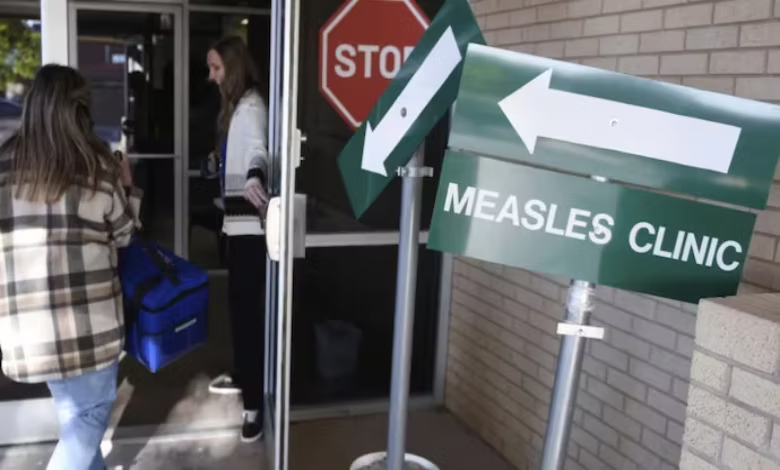US Measles Outbreak Grows: Over 700 Cases Across Six States Here’s what to know

Washington: Measles cases in the United States have climbed to over 700, with six states now experiencing active outbreaks. Indiana became the latest to join, while Texas saw a sharp rise of 60 additional infections. Authorities also confirmed a third death related to measles this week.
Health Secretary Robert F. Kennedy Jr. stated during a televised Cabinet meeting on Thursday that cases may be stabilizing nationally. However, the disease continues to spread, particularly among unvaccinated individuals. The CDC has redeployed a response team to address the crisis in West Texas.
The U.S. has already reported more than twice as many cases as it did in all of 2024. Texas accounts for the majority, recording 541 cases.
Two of the reported deaths in Texas were unvaccinated schoolchildren from a rural West Texas community, where the outbreak is centered. Kennedy visited the affected area on Sunday. New Mexico reported a third death — an unvaccinated adult — linked to the same outbreak.
Other states with ongoing outbreaks, defined as three or more related cases, include New Mexico, Indiana, Kansas, Ohio, and Oklahoma. The WHO has also traced measles cases in Mexico to the outbreak in Texas.
Measles is an airborne, highly contagious virus that spreads through coughing, sneezing, or breathing. Although preventable with vaccines, it has made a comeback despite being considered eliminated in the U.S. since 2000.
Here’s what else you need to know about measles in the US.
How many measles cases are there in Texas and New Mexico?
Texas’ outbreak, which began in late January, has now affected 541 people across 22 counties, primarily in West Texas. Sixty-five percent of these cases are from Gaines County, where the virus has rapidly spread within an undervaccinated Mennonite community. Two children — aged 6 and 8 — died from measles complications in recent weeks.
In New Mexico, two more cases were reported Friday, bringing the total to 58. Genetic testing linked the cases to the Texas outbreak. Most infections are concentrated in Lea County, with others in Eddy and Chaves counties. The state also recorded a measles-related adult death on March 6.
How many cases are there in Kansas?
Kansas has confirmed 32 measles cases across eight southwestern counties. Haskell County leads with eight cases, followed by Stevens with seven and Kiowa with six. Genetic analysis suggests a link to the Texas and New Mexico outbreaks, though the original exposure source is still unknown.
How many cases are there in Oklahoma?
Oklahoma’s total measles count rose to 12, with nine confirmed and three probable cases. Initial infections are connected to the West Texas and New Mexico outbreaks. Confirmed exposures occurred in Tulsa and Rogers counties.
How many cases are there in Ohio?
Ohio has reported 20 measles cases so far: 11 in Ashtabula County, seven in Knox County, and one each in Allen and Holmes counties. The Knox County outbreak includes nonresidents, but only Ohio residents are counted in official numbers. The initial Ashtabula case was an unvaccinated adult who had contact with someone recently returned from abroad.
How many cases are there in Indiana?
Indiana has six confirmed cases in Allen County, including four unvaccinated minors and two adults of unknown vaccination status. Officials say the cases are not linked to other known outbreaks.
Where else is measles showing up in the US?
Additional cases have been recorded in at least 19 other states, including California, Florida, and New York. The CDC has identified seven active outbreak clusters so far in 2025. Many U.S. outbreaks begin with imported cases that spread in communities with low vaccination coverage. In 2019, the U.S. came close to losing its measles elimination status with 1,274 cases. As of now in 2025, 712 cases have been confirmed by the CDC.
Do you need an MMR booster?
The MMR vaccine — for measles, mumps, and rubella — is the most effective protection. Children should receive their first dose between 12–15 months, and a second between ages 4–6. High-risk individuals in outbreak areas may need a booster, especially if they live with infected persons or have underlying health issues. Those born before 1957, or who can document past vaccination or infection, are generally considered immune. Lab testing for immunity is available but not always recommended or covered by insurance. The CDC notes that receiving an extra MMR shot poses no harm.
What are the symptoms of measles?
Measles typically begins with respiratory symptoms: fever, cough, runny nose, and red eyes, followed by a rash that starts on the face and spreads downward. The rash usually appears 3–5 days after the initial symptoms, with fevers potentially exceeding 104°F. Complications can include pneumonia, brain inflammation, blindness, and even death.
How is measles treated?
There is no cure for measles. Treatment focuses on symptom management and preventing complications.
Why are vaccination rates important?
Herd immunity, achieved when over 95% of a population is vaccinated, helps prevent the spread of infectious diseases like measles. However, U.S. vaccination rates have declined since the COVID-19 pandemic, with more parents claiming religious or personal exemptions. In 2024, the U.S. experienced a major measles outbreak in Chicago, with over 60 cases — a sign of the growing threat posed by low vaccine uptake.




